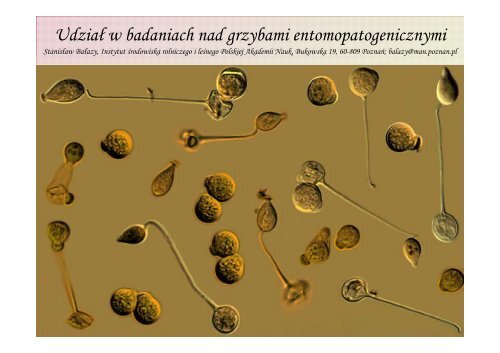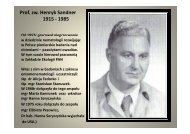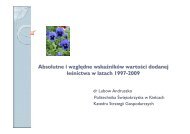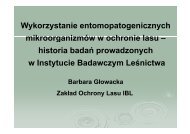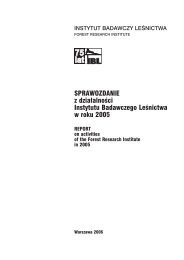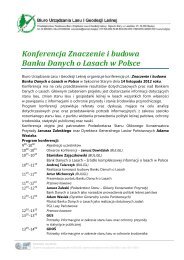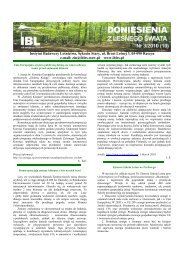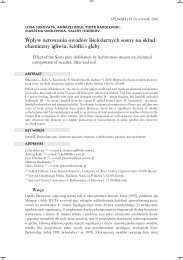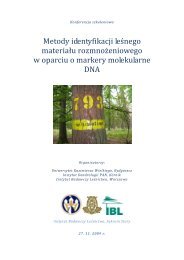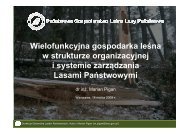and sporulation structures of Hirsutella vandergeesti (2)
and sporulation structures of Hirsutella vandergeesti (2)
and sporulation structures of Hirsutella vandergeesti (2)
You also want an ePaper? Increase the reach of your titles
YUMPU automatically turns print PDFs into web optimized ePapers that Google loves.
Udział w badaniach nad grzybami entomopatogenicznymi<br />
Stanisław Bałazy, Instytut środowiska rolniczego i leśnego Polskiej Akademii Nauk, Bukowska 19, 60-809 Poznań; balazy@man.poznan.pl
Beauveria eauve ia Gloeocystidium
Research Centre for Agricultural <strong>and</strong> Forest Environment <strong>of</strong> the<br />
Polish Academy <strong>of</strong> Sciences (RCAFE), 60-809 Poznań, Bukowska<br />
str. 19, Pol<strong>and</strong><br />
Fungal diseases <strong>of</strong> invertebrates<br />
Stanisław Bałazy<br />
in decaying wood
Entomophagous arthropods <strong>and</strong> pathogens<br />
connected with eight-toothed g bark beetle (Ips ( p typographus) yp g p ) <strong>and</strong> allied spruce p bark beetles<br />
1. Ovivorous mites<br />
Iponemus gaebleri<br />
I. balazyi<br />
Dendrolaelaps spp. <strong>and</strong> about 15 other<br />
gamasid species<br />
Pyemotes dryas<br />
2. Predacious insects<br />
About 15 bug <strong>and</strong> beetle species<br />
3. Parasitoids <strong>of</strong> adult beetles<br />
Rhopalophorus clavicornis<br />
Timicobia seitneri<br />
Mesopolobus typographi - hyperparasitoid<br />
Cosmophorus klugii<br />
C. regius<br />
Karpinskiella pityophthori<br />
4. A group <strong>of</strong> non-selective entomophagous insects<br />
About 20 species <strong>of</strong> Coleoptera <strong>and</strong> 15 <strong>of</strong><br />
Diptera, Heteroptera <strong>and</strong> Neuroptera.<br />
3. Parasitoids <strong>of</strong> larvae <strong>and</strong> pupae<br />
Coeloides bostrychorum<br />
Dendrosoter middendorfi<br />
Ecphylus hylesini<br />
Dinotiscus eupterus<br />
Eurytoma aethiops<br />
Eurytoma arctica<br />
Eurytoma spp.<br />
E. morio<br />
Gelis gentilis - hyperparasitoid<br />
Gelis sp. - hyperparasitoid<br />
Heydenia praetiosa<br />
Ipideurytoma spessivtsevi<br />
Metacolus unifasciatus<br />
Rhopalicus tutele<br />
Roptrocerus xylophagorum<br />
R. mirus<br />
Nasonia vitripennis<br />
Nemeritis transfuga<br />
Nemeritis sp.<br />
Neurateles papyraceus<br />
Serphus gravidator<br />
Proctotrupidae
6. Pathogens <strong>of</strong> premature instars <strong>and</strong> adult beetles<br />
Bakteria - (poorly (p y recognized g –ca. 5 species) p )<br />
Fungi: Aphanocladium album<br />
Beauveria bassiana<br />
B. brongniartii<br />
Chytridiopsis typographi<br />
Conidiobolus coronatus<br />
H. cf. brownorum<br />
H. haptospora<br />
H. nodulosa<br />
<strong>Hirsutella</strong> rostrata<br />
<strong>Hirsutella</strong> sp.<br />
Isaria farinosa<br />
Lecanicillium muscarium<br />
Lecanicillium spp.<br />
Metarhizium anisopliae<br />
Si Simplicilium li ili spp.<br />
Tarichium spp.<br />
Nematoda:<br />
IIn adults: d lt<br />
Contortylenchus diplogaster<br />
Parasitorhabditis obtusa<br />
Polymorphotylenchus typographi<br />
SSulphuraetylenchus l h t l h sulfureus lf<br />
In larvae – invasive instars <strong>of</strong> unidentified species<br />
(about 15 species)<br />
<strong>Hirsutella</strong> cf. brownorum<br />
Protozoa<br />
GGregarina i ttypographi hi<br />
Nosema typographi<br />
Schizogragarinida (inidentified sp.)<br />
Unicaryon sp.
Development <strong>of</strong> Neozygites abacaridis in the gall-mite Abacarus hystrix (1)<br />
<strong>and</strong> <strong>sporulation</strong> <strong>structures</strong> <strong>of</strong> <strong>Hirsutella</strong> v<strong>and</strong>ergeesti (2)<br />
1 2
Entomophthora sp. cf. muscae<br />
Entomophaga tipulae<br />
Batkoa apiculata – resting spores<br />
Cordyceps ithacensis Paecilomyces tenuipes<br />
<strong>Hirsutella</strong> lecaniicola – anamorph <strong>of</strong> Cordyceps clavulata
Nieokreślone przyczyny zamierania larw ogłodka brzozowca w Borach Tucholskich
The old, ab<strong>and</strong>oned feeding sites become normally settled by consecutively changing saprotrophic<br />
nematode, t d mite it <strong>and</strong>d iinsectt communities, iti ussually ll ddominated i t d bby springtails, i t il sciarid i id llarvae <strong>and</strong>d gamasid id<br />
or tarsonemid mites, subject to the sawdust changes similar to over-fertilized organic soils. In such<br />
material the species <strong>Hirsutella</strong> minnesotensis originally occurring on nematodes in arable soils was<br />
found on juvenile j <strong>and</strong> adult tarsonemids.<br />
<strong>Hirsutella</strong> minnesotensis on tarsonemid female
<strong>Hirsutella</strong> rostrata on Dendrolaelaps sp <strong>and</strong> on a predacious beetle larva<br />
<strong>Hirsutella</strong> rostrata on Dendrolaelaps sp. <strong>and</strong> on a predacious beetle larva<br />
Mycelium <strong>and</strong> Dictyochlamydospores
A springtale infected by Conidiobolus coronatus<br />
<strong>Hirsutella</strong> sp. in proctotrupid wasp<br />
<strong>Hirsutella</strong> sp. on a braconid wasp<br />
(the arrows indicate the fungus synnemata)
Contrary to the foli<strong>of</strong>agous <strong>and</strong> soil inhabiting noxious insects, epizootics caused by the entomopathogenic fungi in<br />
subcortical pest populations have been rather rare <strong>and</strong> never so spectacular. This can be caused by the strongly<br />
limited possibilities <strong>of</strong> direct artropod-pathogen contact, rather few infective units transmitted to subcortical<br />
habitats by parental cambio- or xylophagous hosts as well as by rather isolated their feeding in larval galleries.<br />
Entomophthora syrphi on Melanostoma scalare<br />
Furia sciare on sciariid flies P<strong>and</strong>ora neoaphidis on Microlophium carnosum
Table 1. Selected d examples p s o<strong>of</strong> beneficial arthropod opod mycoses y os s (sp (species s<br />
linked with particular arthropod groups distinguished by boldface).<br />
Parasitoids - Hymenoptera Hymenoptera, Parasitica Parasitica Spiders - Arachnida<br />
Arachnida<br />
Batkoa major Acremonium spp.<br />
Beauveria bassiana Aphanocladium album<br />
<strong>Hirsutella</strong> in Serphus sp. Beauveria bassiana<br />
Paecilomyces farinosus B. brongniartii<br />
P<strong>and</strong>ora dacnusae Gibellula leiopus<br />
Zoophthora ichneumonis G. pulchra<br />
Zoophthora Zoophthora cf. cf. lanceolata lanceolata Hymenostilbe Hymenostilbe aranearum<br />
aranearum<br />
Verticillium lecanii <strong>Hirsutella</strong> aranearum<br />
Lecanicillium aranearum<br />
Ants – Hymenoptera, Formicoidea Lecanicillium spp.<br />
Aegeritella i ll spp.<br />
Batkoa apiculata<br />
Paecilomyces l farinosus f<br />
Beauveria bassiana Harvest spiders - Opiliones<br />
Cordyceps Cordyceps myrmecophila myrmecophila B. B. bassiana bassiana<br />
P<strong>and</strong>ora myrmecophaga Entomophaga batkoi<br />
Lecanicillium lamellicola<br />
Paecilomyces farinosus<br />
Metarhizium Metarhizium anisoplia anisoplia<br />
P<strong>and</strong>ora phalangicida
• Ground beetles - Coleoptera, Carabidae Predaceous mites - Acari<br />
• Beauveria bassiana Acremonium sp<br />
• Cordyceps entomorrhiza Aphanocladium album<br />
• <strong>Hirsutella</strong> cf. eleutheratorum Beauveria bassiana<br />
• Lecanicillium cf. lecanii B. brongniartii<br />
• Metarhizium anisopliae Conidiobolus chlapowskii<br />
• Paecilomyces farinosus C. coronatus<br />
• <strong>Hirsutella</strong> brownorum<br />
• Hgregis H. gregis<br />
• Other predaceous beetles H. haptospora<br />
• Beauveria bassiana H. cf. minnesotensis<br />
• B. brongniartii H. nodulosa<br />
• <strong>Hirsutella</strong> sp. I H. rostrata<br />
• <strong>Hirsutella</strong> sp. II Tarichium sp. about 10 species<br />
• Lecanicillium spp. Lecanicillium lamellicola<br />
• Metarhizium anisopliae LL. lecanii<br />
• Paecilomyces farinosus L. psalliotae<br />
• P. fumosoroseus<br />
• P. tenuipes<br />
• Paecilomyces in Lampyris
Gibellula pulchra on a spider
Eryniopsis caroliniana<br />
<strong>Hirsutella</strong> aphidis<br />
<strong>Hirsutella</strong> acridiorum<br />
Entomophaga tenthredinis<br />
Batkoa apiculata
Akanthomyces aculeata<br />
na motylu<br />
Hymenostilbe sp.<br />
na pająku<br />
Nieokreślony gatunek na Pterostichus sp.<br />
EErynia i rhizospora hi na chruścikach h ś ik h
Isaria dubia<br />
CC. gracilis<br />
ili<br />
Tilachlidiopsis p nigra g – C. entomorhizza<br />
Cordyceps militaris<br />
Maczużniki<br />
(Cordyceps)<br />
ii i ich h<br />
anamorfy
Cordyceps gracilis <strong>and</strong> the synnemata<br />
<strong>of</strong> its anamorph (Paraisaria dubia)<br />
Cordyceps clavulata <strong>and</strong><br />
<strong>Hirsutella</strong> lecaniicola
Morrtality<br />
(% )<br />
epizootic level<br />
enzootic level<br />
Months<br />
- .- .- .- E.batkoi on harvest-spiders Oligolophus tridens.<br />
--------- Zoophthora bialoviezaensis on foliophagous geοmetrid caterpillars.<br />
xoxoxo Entomophthora culicis on chironomid adults in l<strong>and</strong>-water ecotones.<br />
- .- .- .- Ζ. arginis g on larvae <strong>of</strong> Arge g berberidis.<br />
……... ΕΕ. muscae on adult calyptrate flies. flies<br />
--------- Ζ. aphrophorae on Dicyphus pallidus.<br />
……... Conidiobolus obscurus on different aphid species.<br />
xxxxxx Ζ. rαdicans on Pieris brassicae caterpillars.<br />
xxxxxx Neozygites floridana on Tetranychus urticae.<br />
oooooo Ζ. phytonomi on Phytonomus spp. larvae in alfalfa.<br />
oooooo Tarichium rhagonycharum on adults <strong>of</strong> Rhagonycha lignosa in forests.<br />
xxxxxx Erynia conica on Chironomidae, Culicidae allied gnats.<br />
- .- .- .- Cordyceps entomorrhiza on larvae, pupae or adults <strong>of</strong> Carabus spp.<br />
- .- .- .- P<strong>and</strong>ora neoaphidis on different aphid species.<br />
______ Beauveria bassiana on different species in forest litter. litter<br />
xoxoxo P<strong>and</strong>ora echinospora on adult laιιxaniid flies.<br />
______ Paecilomyces farinosus on larvae <strong>and</strong> pupae <strong>of</strong> Microlepidoptera.<br />
xoxoxo Furia sciarae on adult sciarids in moist deciduous forest undergrowth.<br />
--------- Lecanicillium spp. on Aphidoidea <strong>and</strong> Orthezia urticae.<br />
……... Entomophaga tenthredinis on tenthredinid larvae.<br />
oooooo Gibellula pulchra on spiders in moist grassl<strong>and</strong>s
Numbers <strong>of</strong> anemoconidia <strong>of</strong> Beauveria bassiana <strong>and</strong> Paecilomyces<br />
farinosus (in millions per 1m2 ) estimated on the basis <strong>of</strong> dead insects found<br />
on research plots (different letters indicate statistically significant values,<br />
the asterisks (*) – highly significant; Whitney-Mann U-test)<br />
Habitat Pologne Romania France<br />
Forests 711,3 A� 1224,1 A� 176,8 A�<br />
Mid-field afforestations 116,3 B 636,3 B 190,2 A�<br />
Perennial crops <strong>and</strong> grassl<strong>and</strong>s 112,6 B 624,2 1) B 161,0 A�<br />
Annual crops 55C� 5,5 C� 83 83,2 2 B� B� 08B 0,8 B<br />
1) only y<br />
alfalfa cultures.
Almost all entomophthoralean species affecting holometabolic insects have<br />
been specialized to infect only their one – larval by or adult - development<br />
instar.<br />
The larval mortality, caused mostly by the pathogens <strong>of</strong> the genera<br />
Entomophaga <strong>and</strong> Zoophthora, is commonly <strong>of</strong> great importance for the plant<br />
protection t ti bboth th iin agriculture i lt <strong>and</strong>d fforestry. t<br />
On the other h<strong>and</strong>, frequent cases <strong>of</strong> very high mortality <strong>of</strong> adult anthomyid<br />
flies caused by Entomophthora muscae do not reduce significantly their<br />
populations l ti bbecause <strong>of</strong>f hhost’ t’ddying i after ft oviposition i iti period. i d<br />
Dipteran larvae generally appear to be resistant to infection both by the<br />
entomophthoralean <strong>and</strong> mitosporic fungi.<br />
Heavy epizootics caused in moist bushy or forest habitats by Paecilomyces<br />
suffultus in gregarious bibionid larvae were not frequent exceptions. This<br />
fungus merits to be tested for the pathogenicity to other dipteran larvae, as a<br />
potential supplementary agent agent.
Micromorphology <strong>of</strong> some anamorphs<br />
Paecilomyces farinosus<br />
Gibellula<br />
<strong>Hirsutella</strong><br />
Beauveria<br />
Nomuraea<br />
Lecanicillium
Identification <strong>of</strong> <strong>Hirsutella</strong>-species is generally difficult because <strong>of</strong> the<br />
scarcity <strong>of</strong> differentiating features <strong>and</strong> very great similarity <strong>of</strong> morphological<br />
elements bearing taxonomical value. Some <strong>of</strong> them are able to infect both insects<br />
<strong>and</strong>d mites it or nematodes t d <strong>and</strong>d mites, it as ffor iinstance t HH. nodulosa d l <strong>and</strong>d HH. minnesotensis<br />
i t i<br />
respectively. Lately also H. rostrata – known only from mites – was found on a ciidbeetle<br />
larva.<br />
Neither strains <strong>of</strong> H. thompsonii, H. minnesotensis or H. rostrata infected<br />
insects in laboratory assays (caterpillars <strong>of</strong> the codling moth <strong>and</strong> larve <strong>of</strong> birch barkbeetle)<br />
whereas H. nodulosa caused single positive cases in the later.<br />
Though by biotests are necessary to check the strain pathogenicity to the<br />
other th gropus iinvertebrates, t b t th the main i diffi difficulty lt iin th the llaboratory b t bi bioassays with ith some<br />
<strong>Hirsutella</strong> strains is to obtain a sufficient amount <strong>of</strong> spores for required<br />
concentration <strong>of</strong> infective suspensions<br />
(e. ( g. g the strain 3747 m – <strong>of</strong> H. cf. brownorum sporulates p extremelyy weakly). y)<br />
H. minnesotensis shows very close morphological similarity to H.<br />
thompsonii but the DNA ITS region sequencing <strong>of</strong> its strains from tarsonemid mites<br />
excludes their identity, whereas the sequencies <strong>of</strong> its strains from insects <strong>and</strong><br />
ttarsonemid id mites it did nott diff differ.<br />
Several further specimens <strong>and</strong> cultures <strong>of</strong> <strong>Hirsutella</strong> from hitherto unknown<br />
insect <strong>and</strong> mite hosts are currently investgated in order to correct idebtification.
Though the first fungous diseases <strong>of</strong> mites have been recognized in the<br />
turn <strong>of</strong> XIXth century deepened studies on them were concentrated mostly in<br />
regions, where phytophagous groups <strong>of</strong> mites constitute real problems in<br />
plant pathology. In Pol<strong>and</strong> first reports on hyphomycetous <strong>and</strong><br />
entomophthoralean diseases in mites appeared only in the second half <strong>of</strong><br />
XXth century y (Bałazy ( y 1970, , Bałazyy <strong>and</strong> Wiśniewski 1984, , Bałazyy et al. 1986). )<br />
By the end <strong>of</strong> 1990s co-ordinated research projects concerning occurrence<br />
<strong>and</strong> significance od mycoses in different groups <strong>of</strong> phytophagous,<br />
saprotrophic <strong>and</strong> beneficial mites were undertaken (Miętkiewski et al. 2000).<br />
Till now mycoses <strong>of</strong> two groups <strong>of</strong> mites have been recognized:<br />
(1) - phytophagous spider- <strong>and</strong> gall-mites in gardens, orchards <strong>and</strong> grassl<strong>and</strong>s;<br />
(2) - associations <strong>of</strong> saprotrophic <strong>and</strong> predacious mites occurring commonly in<br />
subcortical b ti l iinsect t ffeeding di grounds d ontrees.<br />
t
Differentiation <strong>of</strong> H. thompsonii strains on the same medium
Within the hyphomycetes <strong>Hirsutella</strong> <strong>and</strong> Lecanicillium anamorphs show<br />
very great variability <strong>and</strong> limited number <strong>of</strong> the morphological features,<br />
that would merit the value <strong>of</strong> criteria for their taxonomy. Modern<br />
approach based on DNA sequencioning <strong>of</strong> ITS region allowed to select<br />
from the collected strains some separated p groups. g p<br />
+NEMATODES<br />
MITES<br />
MITES<br />
NEMATODES<br />
MITES


